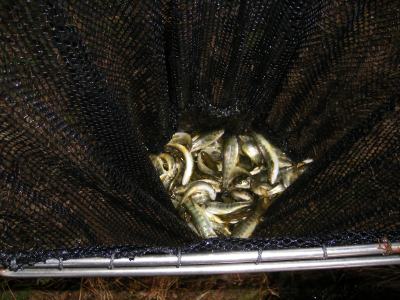The River Axe received a welcome boost, this week, as thousands of young salmon and sea trout were released into its tributaries by the Environment Agency and a local rivers association.
The re-stocking is part of an ongoing programme to improve river conditions and fish stocks on the Axe and follows the successful completion, earlier this summer, of a new fish pass at Wilmington Weir near Axminster.
The young salmon and sea trout are the offspring of adult fish on the Axe that were stripped of their eggs and milt (sperm) in 2006. The eggs were then taken to a hatchery in Wales and reared as fry before returning to Devon and released into the Axe as ‘fingerlings.’
The rearing of young fish in this way ensures a higher survival rate than would occur naturally and provides more fish for re-stocking.
More than 11,000 young salmon were collected from Wales by Agency officers. Several hundred were released into the Axe at Wilmington. The remainder are being kept in a holding pond prior to release to increase their chances of survival. In a separate operation, the Axe Vale Rivers Association released 8,319 sea trout fingerlings into four tributaries of the Axe including the Yarty, Umborne Brook, River Blackwater and River Synderford.

The new fish pass has been built into a weir on the Umborne Brook near the Wilmington Fish Farm and enables salmon and sea trout to reach previously inaccessible spawning grounds.
‘For many years Wilmington Weir was a major obstacle to migrating salmon and sea trout. This new fish pass will open up approximately 10 km of prime spawning grounds and greatly improve biodiversity further up the river, encouraging otters, kingfishers and bittern. It is also hoped other migratory fish such as lamprey and eels, which are under threat, will also return in greater numbers,’ said Andy Locke for the Environment Agency.
Like many salmon rivers, the Axe has a Salmon Action Plan that pinpoints the main threats to local salmon stocks and helps the Agency decide how best to boost fish numbers.
One of the biggest threats on the Axe is the silting up of spawning grounds. Fine soil particles washed into the river from surrounding farmland can clog gravels beds and reduce the breeding success of salmon by preventing eggs from hatching. In recent years the Environment Agency has worked closely with local landowners and farmers to tackle siltation.
The benefits of re-stocking were clearly demonstrated in 2006 when fish that had been reared by the Agency returned to the River Axe for the first time. The fish had been ‘fin-clipped’ which made them easily identifiable. Fisheries officers will be monitoring the local salmon and sea trout populations to determine how many of the latest batch of young fish return in future years.
Anglers on the Axe are helping conserve salmon stocks by supporting a catch and release scheme that operates throughout the fishing season and increases the number adult fish available to breed.
While salmon normally only return to their home river to spawn once (exceptionally twice), sea trout can return up to 10 times. This is because they tend to only inhabit UK coastal waters whereas salmon travel much further afield to rich feeding grounds off the Faeroe Isles.









